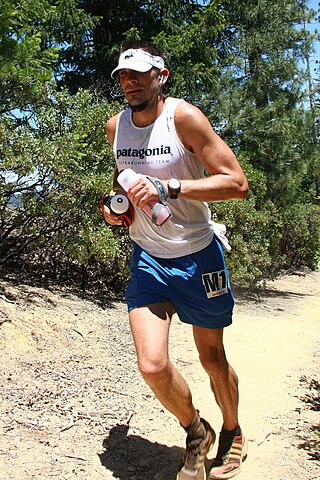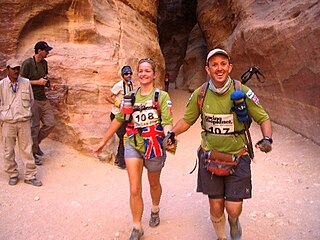
Running is a method of terrestrial locomotion allowing humans and other animals to move rapidly on foot. Running is a type of gait characterized by an aerial phase in which all feet are above the ground. This is in contrast to walking, where one foot is always in contact with the ground, the legs are kept mostly straight and the center of gravity vaults over the stance leg or legs in an inverted pendulum fashion. A feature of a running body from the viewpoint of spring-mass mechanics is that changes in kinetic and potential energy within a stride co-occur, with energy storage accomplished by springy tendons and passive muscle elasticity. The term running can refer to any of a variety of speeds ranging from jogging to sprinting.

The term antelope is used to refer to a number of species of ruminant artiodactyls—i.e., multiple-stomached, cud-chewing, even-toed hoofed mammals—that are indigenous to most of Africa, India, the Middle East, Central Asia, and a small area of Eastern Europe.

In sports, racing is a competition of speed, in which competitors try to complete a given task in the shortest amount of time. Typically this involves traversing some distance, but it can be any other task involving speed to reach a specific goal.

Long-distance running, or endurance running, is a form of continuous running over distances of at least 3 km (1.9 mi). Physiologically, it is largely aerobic in nature and requires stamina as well as mental strength.

An ultramarathon, also called ultra distance or ultra running, is any footrace longer than the traditional marathon length of 42.195 kilometres. Various distances are raced competitively, from the shortest common ultramarathon of 31 miles (50 km) to over 200 miles (320 km). 50k and 100k are both World Athletics record distances, but some 100 miles (160 km) races are among the oldest and most prestigious events, especially in North America.

Trail running is a type of running that takes place on outdoor trails, often in mountainous terrain, and often includes significant ascents and descents. Trail running is overseen by the International Trail Running Association (ITRA) and includes longer races.

Coursing by humans is the pursuit of game or other animals by dogs—chiefly greyhounds and other sighthounds—catching their prey by speed, running by sight, but not by scent. Coursing was a common hunting technique, practised by the nobility, the landed and wealthy, as well as by commoners with sighthounds and lurchers. In its oldest recorded form in the Western world, as described by Arrian – it was a sport practised by all levels of society and it remained the case until Carolingian period forest law appropriated hunting grounds, or commons, for the king, the nobility, and other land owners. It then became a formalised competition, specifically on hare in Britain, practised under rules, the Laws of the Leash.

Dean Karnazes, is an American ultramarathon runner, and author of Ultramarathon Man: Confessions of an All-Night Runner, which details ultra endurance running for the general public.
Multiday races are ultramarathon running events which are typically either segmented into daily events of a specified distance or time, or staged so that runners can run as far as they want, at their own discretion, over a set course or over a set number of days. Multiday races can range from continuous 48-hour track events to staged transcontinental treks.
Bernd Heinrich, is a professor emeritus in the biology department at the University of Vermont and is the author of a number of books about nature writing and biology. Heinrich has made major contributions to the study of insect physiology and behavior, as well as bird behavior. In addition to many scientific publications, Heinrich has written over a dozen highly praised books, mostly related to his research examining the physiological, ecological and behavioral adaptations of animals and plants to their physical environments. He has also written books that include more of his personal reflections on nature. He is the son of Ichneumon expert Gerd Heinrich.

The Barkley Marathons is an ultramarathon trail race held each year in Frozen Head State Park in Morgan County, Tennessee.

Hal Koerner is an American distance runner specializing in ultramarathon running. He is the owner of a specialty running store, Rogue Valley Runners, located in the mountainous Southern Oregon town of Ashland. He is one of the subjects of JB Benna's feature-length documentary "Unbreakable: The Western States 100".

RacingThePlanet (RTP) is an organizer of off-trail and rough-country endurance foot-races, including the 4 Deserts. The company also operates an outdoor products store and a dried foods company.
Amy Palmiero-Winters is a below-knee amputee who currently holds eleven world records in various events. In 2010, she was awarded the James E. Sullivan Award as the top amateur athlete in the United States and the ESPN ESPY Award as the top female athlete with a disability in the world.
The Ultra Maratón Caballo Blanco is a 50-mile ultramarathon held annually in the town of Urique, in the northern Mexican state of Chihuahua.
Samantha Gash is an Australian professional endurance athlete, social entrepreneur, motivational speaker. As an endurance athlete, Gash focuses on long distance expedition runs and adventure races. She is an ambassador to numerous organizations and events including World Vision, Lululemon Athletica, Run Melbourne and Travel Play Live.

Sage Clifton Read Canaday is an American long-distance runner and ultramarathoner.

Mónica Fernández, better known as Toti Fernández is a triathlete and ultramarathon runner, lecturer, author, entrepreneur and mother. She won the 2000 and 2001 Ultraman events.
Ruby Muir is an ultra-endurance runner from New Zealand. In 2017 she won the national women's cross-country event.
La Ultra is an Ultramarathon and running event held in the Ladakh region of Indian Administered Kashmir. The marathon subjects participants to extreme climate, distances of up to 555 kms, and altitudes of up 17,500ft and is deemed one of the toughest runs in the world.












